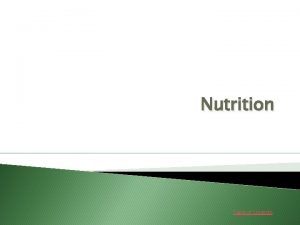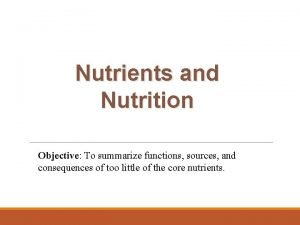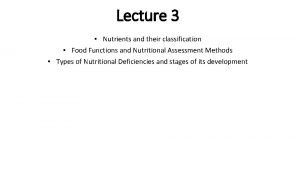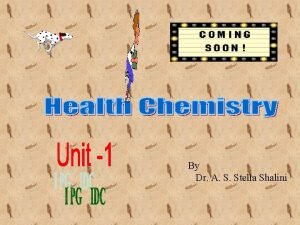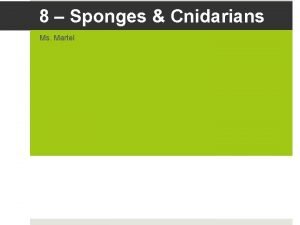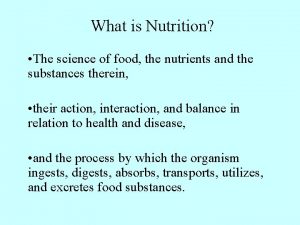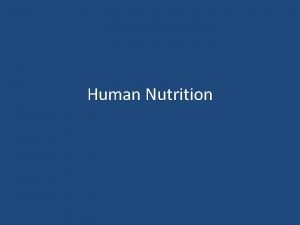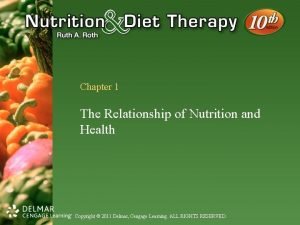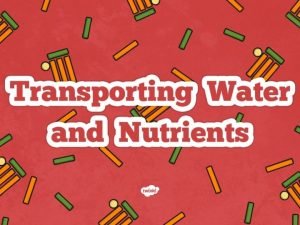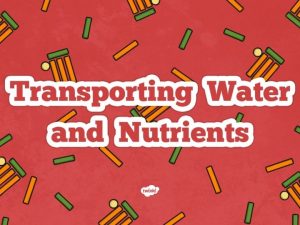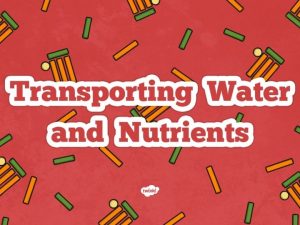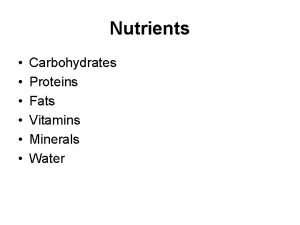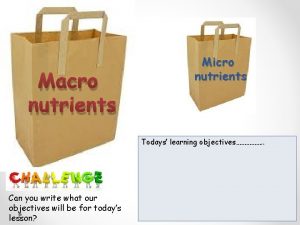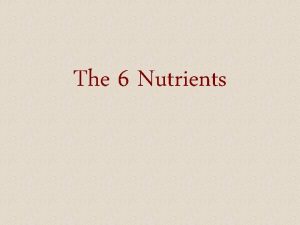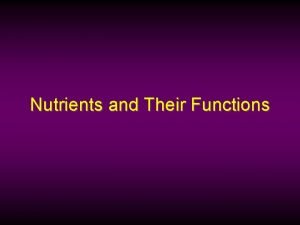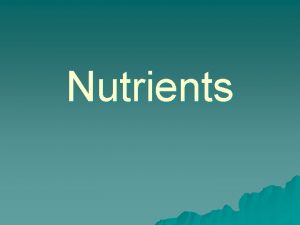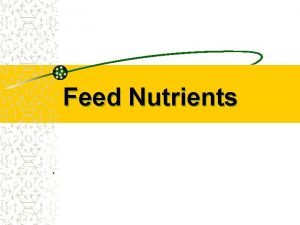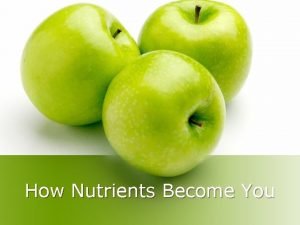I can explain how water and nutrients are












- Slides: 12


• I can explain how water and nutrients are transported within the body. • I can state how the digestive system breaks down nutrients. • I can explain the role of circulatory system in transporting nutrients and water in the body.

Match the type of nutrient with the job that it does. Help the body to stay healthy. For example Vitamin C helps wounds to heal. Needed for cells to function normally and body fluids. Gives the body energy so we can be active. Help the body to grow and repair itself. Keep the body healthy. For example: calcium keeps our teeth strong and iron is needed to help circulate oxygen around the body. Gives the body energy, stores energy and helps insulate against the cold. Helps keep food moving through the colon and intestines.

Match the type of nutrient with the job that it does. Help the body to grow and repair itself. Help the body to stay healthy. For example Vitamin C helps wounds to heal. Keep the body healthy. For example: calcium keeps our teeth strong and iron is needed to help circulate oxygen around the body. Gives the body energy so we can be active. Gives the body energy, stores energy and helps insulate against the cold. Helps keep food moving through the colon and intestines. Needed for bodily fluids and normal cell function.

1. Mouth: Food enters the system 2. Salivary glands: Produce saliva which contain an enzyme called amylase. This breaks down starch in carbohydrates. Humans get nutrients 3. Tongue: Mixes food with saliva. from 4. food and drink. This is broken down 4 by 1 the digestive system. 3 Canfood. you remember the functions of the digestive system? Teeth: Tear, cut and grind 2 5. Oesophagus: Tubes that leads food to the stomach. 6. Stomach: Produces enzymes and acids to break food down. Churns food into small pieces. The mixture of stomach acids, enzymes and food is called ‘chyme’ 5 Click me for answers! carbohydrates and proteins which are released into 7. Pancreas: Produces enzymes to break down fats, the duodenum. 8. Liver: Produces bile that breaks down fats. 9. Gall Bladder: Stores bile and releases it to the 8 Duodenum when needed. 6 9 10. Duodenum: First part of the small intestine. Food is broken down by bile and enzymes. 10 7 11. Small Intestine: Nutrients are absorbed into the bloodstream here. Remaining food is passed to the large intestine. 12. Large Intestine: Absorbs water from remaining food. This food forms into stools. 12 11 13. Rectum: Stores stools and signals to the brain that there are stools that need releasing. 13 14. Anus: Stools are released out of the body. 14

How Are Nutrients Broken Down? Stomach acids break food down into a substance called chyme. This passes through to the duodenum where bile and enzymes break up larger molecules into their smaller parts. Starch molecule Sugar molecules Carbohydrase enzymes break down starch (in carbohydrates) into sugars. carbohydrate Protein molecules Amino acid molecules protease Fat molecules Fatty acid and glycerol molecules Protease enzymes break down proteins into amino acids. (Not to be confused with stomach acid!) These are essential to help the body to grow and repair body tissue. In the duodenum, bile from the liver breaks down fat. Then the lipase enzymes break the fat down further into fatty acids and glycerol.

A Closer Look After the nutrients have been broken down into smaller separate molecules in the duodenum, they can then pass through to the rest of the small intestine, where they are absorbed into the blood stream. Inside the Small Intestine muscle layers serosa villus submucosa The small intestine is a muscular tube with several layers. It is lined with tiny hair like villi which are attached to arteries and veins. The chyme (which now contains smaller broken down nutrient molecules) is moved back and forth in the small intestine. The nutrients pass through the villi and are absorbed into the blood vessels. mucosa villi vein artery Bacteria in the large intestine break down waste food for any more nutrients which are absorbed. This process also leads to gas which is eventually passed through the anus.

What about Water? Water enters the body in the mouth. Unlike other nutrients it is not broken down by enzymes or bile. A small amount of water is absorbed through the stomach but the majority passes through to the small intestine. Water is absorbed in the small intestine in the exact same way as other nutrients are absorbed – through the villi into bloodstream via the blood vessels. The large intestine (also called the colon) is similar to the small intestine in structure except that it does not contain villi. By the time waste material reaches the large intestine, 90% of water has already been absorbed. The waste food enters into the cecum which is the first part of the large intestine. It moves through the large intestine through a series of mass movements. These are long, slow moving waves of muscles contracting and relaxing. The rest of the water in the waste food is absorbed in all the different parts of the colon. The resulting stool and any gases are moved to the sigmoid colon. It is this part of the large intestine that enables gases to be released without releasing stools at the same time. The stools then enter the rectum before expulsion through the anus.

How Does It All Fit? Nutrients and water are absorbed in the system in the stomach, small and large intestines. They enter the blood stream via the capillaries where they are passed through to the arteries. The blood is circulated throughout the body (including being oxygenated in the lungs and the heart). Nutrients are absorbed by the cells that need them and water is absorbed by all cells.

How Is Waste Expelled from the Body? kidney bladder urethra There are kidneys are responsible for getting rid of waste from blood in two ways. 1. Veins collect waste from cells. Most of the waste is released into the liver. The liver then uses it to create bile. This goes into the duodenum to break down food into chyme. The waste that is not turned into bile is made water soluble (dissolves in water) and goes to your kidneys. 2. The kidneys perform a function called filtration. The renal vein delivers blood to the kidneys which it filters for waste. This is called ultrafiltrate and is turned into urine which is passed through to the bladder. The bladder serves the same function as the rectum, in that it sends signals to the brain. It sends signals to indicate that urine needs to be expelled. Urine is then released through the urethra.

Please complete the diagram naming the parts of the body and their different functions

• I can explain how water and nutrients are transported within the body. • I can state how the digestive system breaks down nutrients. • I can explain the role of circulatory system in transporting nutrients and water in the body.
 Mikael ferm
Mikael ferm Water and water and water water
Water and water and water water Passageway of water and nutrients
Passageway of water and nutrients The term geologists use for underground water is
The term geologists use for underground water is Food table of contents
Food table of contents Nutrition objective
Nutrition objective Classification of macronutrients
Classification of macronutrients Nutrients and their functions table
Nutrients and their functions table How is waste and nutrients transported in a cnidarian
How is waste and nutrients transported in a cnidarian The science of food the nutrients and substances therein
The science of food the nutrients and substances therein Organic and inorganic nutrients
Organic and inorganic nutrients Nutrients and their functions
Nutrients and their functions Masses of cells form and steal nutrients from healthy cells
Masses of cells form and steal nutrients from healthy cells




